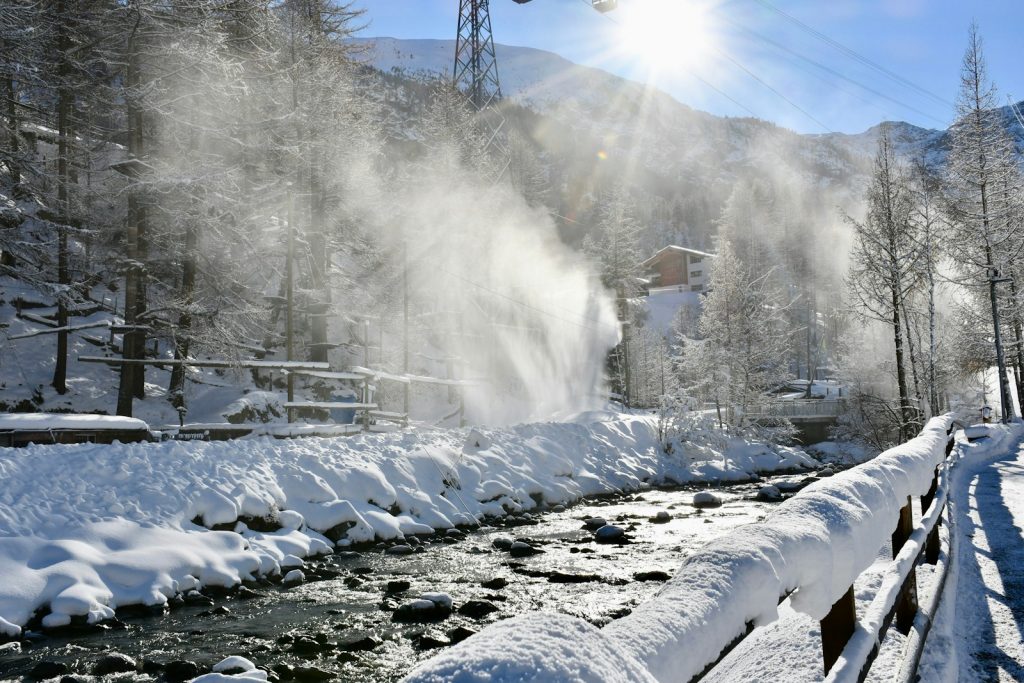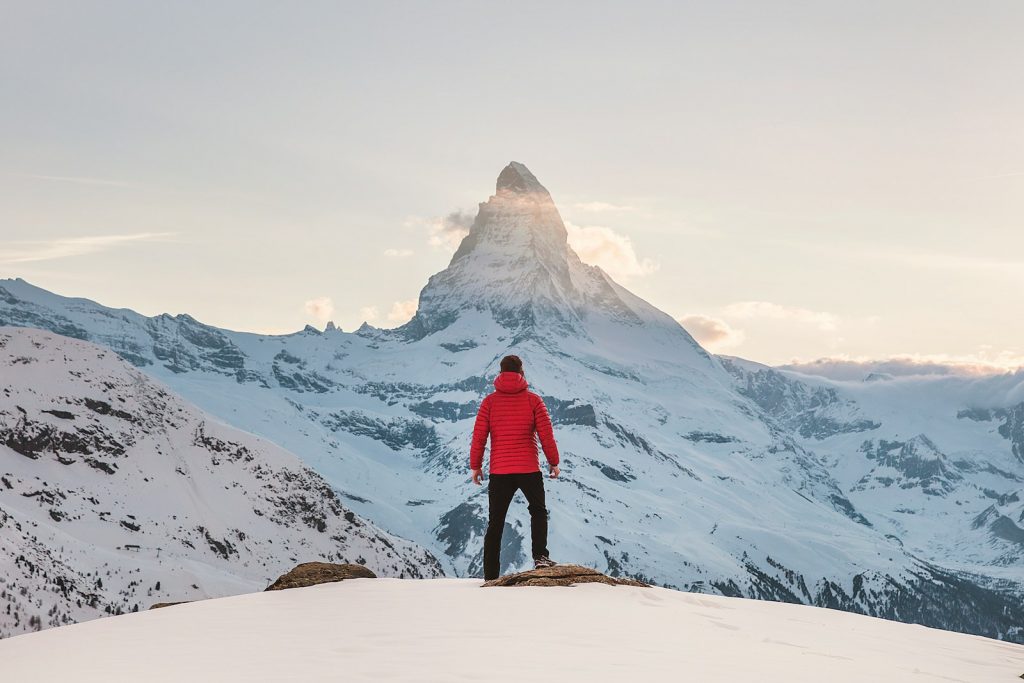Zermatt has over 70km of winter walking & snowshoe trails. Many of these begin/end in the village, and often interlink, providing plenty of options whatever your energy levels.

Do I Need A Lift Pass?
A lift pass isn’t essential if you’re not planning on skiing, but it does open up a much larger area for you to explore and is something that we can definitely recommend, particularly if you are travelling with skiers and would like to meet up for mountain lunches. Peak Passes (the name of the multi-day pass for pedestrians) are cheaper than ski passes, and are available for any duration. Passes can be bought through at any of the village lift stations.
You can buy single/return tickets for all pedestrian-accessible lifts (these can be bought at the village lift stations immediately before travel), but if you are planning on multiple trips up the mountain this is an expensive way to do it. We’d recommend buying a multi-day Peak Pass which includes the following:
- Unlimited use of all pedestrian-accessible lifts & trains in resort
- Free access to the Glacier Palace
- Free access to the Gornergrat Zooom Exhibition
- Free use of regional trains between Zermatt & Randa
- Free use of resort buses
Top Tip:
The 3-in-5 day or 4-in-6 day Peak Passes are a great and economical option, giving you a certain number of days (not required to be consecutive) within a fixed period that you can use the pass. 3 or 4 days is sufficient to explore each of the three mountain areas (Gornergrat, Sunnegga & Klein Matterhorn), and also the walks/activities/restaurants that they have to offer. The remaining days can be spent exploring the many walks that begin/end in the village, and the village itself.
What equipment to bring
For all walks we strongly recommend the use of over-shoe crampons and/or walking poles as the conditions on each route can vary greatly depending on recent weather conditions. These are available to buy in most sports shops in the village.
It’s also worthwhile checking which routes are open, as routes can be shut due to avalanche risk. This information can be found on the resort website, or you can check with your Inghams Representative or hotel reception.

Our favourite trails
Route #’s match the trail numbers shown on the Zermatt winter trail map.
AHV Weg (“Pensioner Path”)
– Route #109 –
- Difficulty: easy
- Distance: 2.1km
This easy trail is a gentle climb from Winkelmatten Kapelle, over the rack-and-pinion tracks of the Gornergrat railway, through the lower reaches of a Stone Pine forest, and slowly back down towards Chalet Hotel Schönegg.
Best timed to finish at around 4pm at the Cervo bar so you can bask in the sunshine and listen to some live Aprés music.
Some steps on the route
Suitable for pulling sledges
Zermatt loop
– Routes # 117 & 120 combined –
Winkelmatten-Moos-Blatten-Furi-Zmutt-Zermatt
| Difficulty | Distance | Duration | Ascent Descent | Lowest Point Highest Point |
| Medium | 10.2km | 3hr 40m | 557m 234m | 1620m 1741m |
To start, follow the road from the last houses in Winkelmatten up to Moos restaurant. From the next corner you follow the trail straight ahead, keeping to the left of the farm buildings (to the right is a ski piste). Part way up the trail crosses the ski piste and takes you through the pine forests and across the Gorner Gorge bridge towards Blatten. From Blatten you can follow the signs to suit your energy levels – either back down to Zermatt, on up to Furi, or even further to Zmutt before looping back to the village.
Take your pick of the lovely slope-side restaurants in Blatten, Zum See or Furi for lunch or refreshments.
If you plan on doing the full loop we recommend you take snacks, or cash, as the restaurants in Zmutt do not accept cards. We also recommend starting early, as the Zmutt route is in the shade during the afternoon, so can be chilly!
Can be completed as a whole walk, or done in smaller sections depending on the length of walk you wish to take. For the whole walk you should allow at least half a day including a lunch/coffee stop.
Rotenboden to Riffelberg
– Route #113 –
Take the train from the Gornergrat station, opposite the main train station in the village centre.
It’s worth taking the train all the way to Gornergrat itself to look at the view (there’s a viewing platform a short walk up from the station with spectacular views across the surrounding mountains and the glaciers), and then taking the train down one stop to Rotenboden. From here you take the path to your right, signposted ‘Winter Wanderweg’, and marked with pink poles. The path is entirely snow covered, and gently winds down to Riffelberg, where you can stop for a coffee and bask in the sunshine on the terrace.
From Riffelberg you have two options:
- Take the train down either all the way back to Zermatt, or just one stop to Riffelalp (where ‘The Night Manager’ was filmed. There are two great lunch/coffee stops here (both accessible to skiers too) – the Riffelalp Resort (great for pizzas) itself, and Alphitta (run by an Irish-Dutch couple – incredible soup and Irish Coffees!)
- Take the train down to Riffelalp and from there follow the walking path back down to Zermatt. It is quite a steep path that can be slippy in places, so over-shoe grips and poles are advised! It also crosses the piste in two places, so it’s best to avoid this route towards the end of the ski day.
The walk from Rifelalp to Zermatt is approximately 1hr.
Blauherd to Fluhalp
– Route #110 –
| Difficulty | Distance | Duration | Ascent Descent | Lowest Point Highest Point |
| Easy | 2.2km | 1hr | 116m 72m | 2523m 2612m |
Take the funicular from the village up to Sunnegga, and the gondola from there up to Blauherd to start the walk.
The sunniest trail in Zermatt during the winter, the route maintains a more or less steady altitude of 2,500 m, following first a track and then a path towards Fluhalp. It’s well worth taking
the time to read the information panels en-route, which describe the survival strategies of the animals that spend the winter here.
Chamois can sometimes be seen grazing on the slopes
Fluhalp restaurant is a great place to stop for lunch or refreshments, with indoor and outdoor seating, spectacular views, and live music most days from 1pm.
The Blue Lounge at Blauherd makes perfect Schümli Pflümli (pronounced shoomly-floomly, but a pear schnapps coffee for the uninitiated). Spectacular views from the terrace, and sheepskin rugs to cosy up in and watch the skiers fly by.
Zermatt to Sunnegga via Tiefenmatten & Findeln
– Route #115 –
| Difficulty | Distance | Duration | Ascent Descent | Lowest Point Highest Point |
| Medium | 6.56km | 2hr 45m | 852m 181m | 1608m 2279m |
A winding climb from the village, beginning just above the Cervo hotel & restaurant. The route takes you along the AHV Weg and through the Stone Pine forest to the picturesque hamlet of Findeln, where you can stop for lunch and refreshments in some of Zermatt’s best known mountain restaurants.